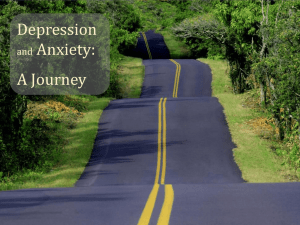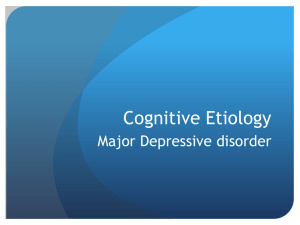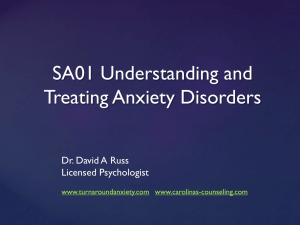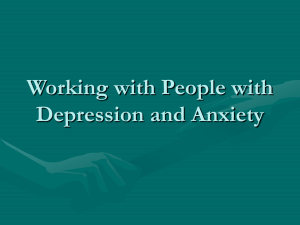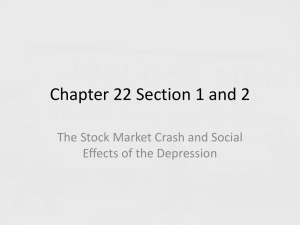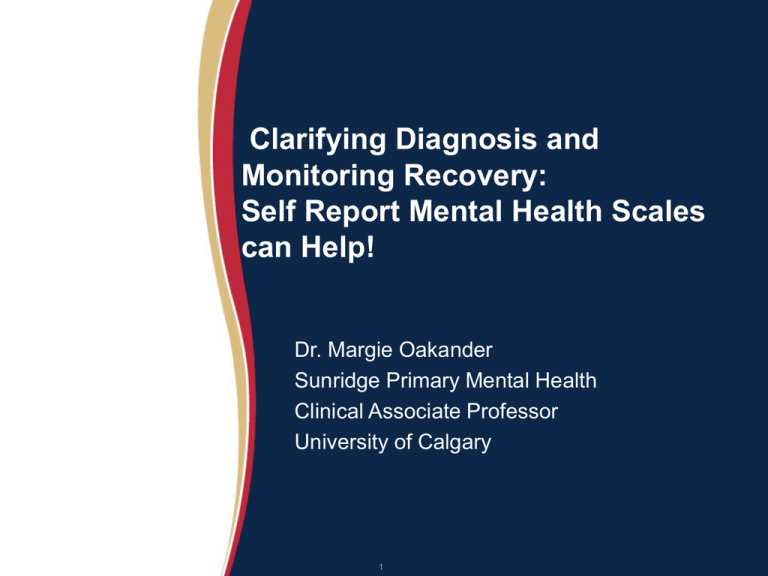
Clarifying Diagnosis and
Monitoring Recovery:
Self Report Mental Health Scales
can Help!
Dr. Margie Oakander
Sunridge Primary Mental Health
Clinical Associate Professor
University of Calgary
1
Disclosure: Dr. Margie Oakander
Advisory Board or Committee: Astra Zeneca, Biovail, GlaxoSmith Kline, Janssen, Lilly,
Lundbeck, Otsuka, Pfizer, Valeant, Wyeth
Honouraria or other fees: Astra Zeneca, Biovail, Bristol Myers Squibb, Janssen,
Lundbeck, Lilly, Otsuka, Pfizer, Shire, Wyeth, Valeant
Research: GlaxoSmithKline, Lilly, Lundbeck, Pfizer, Wyeth
CME Development: Canadian Psychiatric Association
University of Calgary
2
Let’s Start with the many faces of major
depression
DSM-IV criteria
35-year-old
female
70-year-old
male
+ Depressed mood
+ Hypersomnia
+ Increased appetite / weight
+ Psychomotor retardation
+ Difficulty making decisions
+ Suicidal ideation
- Marked loss of interest / pleasure
- Insomnia
- Decreased appetite / weight
- Psychomotor agitation
- Impaired concentration
- Inappropriate guilt
3
DSM 5 Major Depressive Disorder
●Depressed mood
●Loss of interest or pleasure
●Significant changes in weight and/or
appetite
●Insomnia or hypersomnia
●Psychomotor agitation or retardation
●Fatigue or loss of energy
●Feelings of worthlessness or
excessive/inappropriate guilt
●Diminished ability to think or
concentrate, or indecisiveness
●Recurring thoughts of death or suicide,
including plans and attempts
American Psychiatric Association. Diagnostic and Statistical
Manual of Mental Disorders, 5th edition 2013.
4
DSM 5 Criteria: SIGGE-CAPS Mnemonic
S—Suicidal preoccupation
I—Interest/pleasure ()
G—Gain/lose weight
G—Guilty feelings
E—Energy ()
C—Concentration
A—Affect ( mood)
P—Psychomotor retardation
S—Sleep disturbance
DSM-5 major depressive disorder: 5 of 9 symptoms x 2 weeks
Diagnostic and Statistical Manual of Mental Disorders, 5th Edition. 2013.
5
Most frequent conditions leading to short-term and
long-term disability in Canada
Most frequent conditions leading to short-term and long-term disability
in Canada according to employers
85
83
Mental / behavioural health
76
76
Musculoskeletal / back
13
Accident
37
63
Cancer
28
29
Cardiovascular
24
Long-term disability
0
Maternity
Short-term disability
16
1
Gastrointestinal
9
n=87
1
Respiratory
4
1
Genitourinary / urogenital
3
8
8
Other
0
20
40
60
Respondents, %
Note: Respondents were asked to select the top three conditions.
The Conference Board of Canada. 2013.
6
80
100
Global Burden of Disease Study
Top 10 Conditions in High-Income Countries
Ischemic heart disease
8.3
Cerebrovascular
disease
Unipolar depressive
disorders
6.0
5.6
Alzheimer's & other
dementias
5.0
Respiratory cancers
3.6
Adult-onset hearing loss
3.6
COPD
3.5
Diabetes mellitus
2.8
Alcohol use disorders
2.8
Osteoarthritis
COPD: chronic obstructive pulmonary disease;
DALY: disability-adjusted life-year
% of total DALYs lost
2.5
Lopez et al. Lancet 2006;26:1747-57.
Mental illness carries a huge burden to society
The burden of mental illness and addictions in Ontario:
● Is more than 1.5 times that of ALL cancers
● Is more than 7 times that of ALL infectious diseases
● Contributed to loss of 600,000 health-adjusted life years (HALYs)
● Included the top 5 conditions with
highest impact on life and health:
–
–
–
–
–
Depression
Bipolar disorder
Alcohol use disorders
Social phobia
Schizophrenia
Health-adjusted life years (HALYs): A combination of years lived with less than full function and years lost to early death.
Ratnasingham S, et al. Institute for Clinical Evaluative Science, 2012.
8
Considerations for Measurement-based
Care (MBC)
How many people would consider…
Treating diabetes without measuring and following a
patient’s HbA1c?
Prescribing an antihypertensive and not measuring a
patient’s BP?
Measurement-based care (MBC) provides specific and objective
information on which to base clinical decisions and should therefore
enhance quality of care and treatment outcomes.
Rush J. et al., Psychiatric Times. Vol. 26 No. 9 , 2009
Why don’t clinicians use scales to measure
outcome when treating depressed patients?
How often do you use a rating
scale to monitor the course of
treatment for depression?
Why not? Please indicate all that apply.
Percent
Survey of 314 psychiatrists attending
a CME conference in 2006 and 2007.
Reason (N=248)
%
Do not believe it would be
clinically helpful.
28
Do not know what scale to
use.
21
Takes too much time.
34
Too disruptive to practice.
19
Wasn’t trained to use
them.
34
Zimmerman & McGlinchey, J Clin Psychiatry 2006.
Does Measurement-based Care Help Guide Treatment?
Canadian Practice Reflective Audit Results
67% of Primary Care and 77% of psychiatrists made changes to treatment regimens
100%
Primary Care
Specialist
% of Patients
80%
60%
40%
20%
20%
25%
38%
30%
22% 23%
33%
23%
0%
Change Increase dose
Medication of current
medication
Add-on
therapy
No change
* Physicians may have changed more than one part of a patient’s treatment regimen, therefore, percentages do not equal 100%.
Rosenbluth M et al., The Canadian Journal of Diagnosis, June 2011
A Quick Look at the Scales
A Quick Look at the Scales
What makes a scale useful to clinicans and patients?
• Validated
• Sensitive to change
• Brief enough to allow routine administration
• Preferably patient rated
• Easy to administer and require minimal training
PHQ -9 (for Major Depressive Disorder)
GAD-7 (for Generalized Anxiety)
Sheehan Disability Scale (For Functionality)
PHQ-15 (for Physical Symptoms)
BC-CCI (for Cognitive Complaints)
Practical Screening Tool
When Time Is Limited…
The 30 second PHQ-2 depression screen:
Over the past 2 weeks, how often have you
been bothered by any of the following
items?
Not
at All
Several
Days
More
Than
Half the
Days
Nearly
Every
Day
1. Little interest or pleasure in doing things
0
1
2
3
2. Feeling down, depressed or hopeless
0
1
2
3
Cut-off score of 3
• Sensitivity = 83%, specificity = 92% for MDD
Kroenke et al. Med Care 2003;41:1284-94
Patient Health Questionnaire- PHQ 9
• Self-rated scale is the “HbA1c”
of depression.
• Designed specifically for
primary care.
• Highly sensitive and specific
for the diagnosis of
depression.
• Useful in monitoring treatment
response
TOTAL SCORE
DEPRESSION SEVERITY
1-4
Minimal Depression
5-9
Mild Depression
10-14
Moderate Depression
15-19
Moderately-severe Depression
20-27
Severe MDD
PHQ-9 is adapted from PRIME MD TODAY, developed by Drs Robert L. Spitzer, Kurt
Kroenke, and Janet B.W. Williams. Copyright ©1999 Pfizer Inc
Treatment options based on the PHQ9 score
Score Severity
Proposed Treatment Plan
0–4
None-minimal
None
5–9
Mild
Watchful waiting; repeat at follow-up
10 – 14
Moderate
Consider psychotherapy and/or pharmacotherapy
15 – 19
Moderately Severe Consider pharmacotherapy and/or psychotherapy
20 – 27
Severe
Initiate pharmacotherapy and, if severe
impairment, or actively suicidal consider
consultation +/- admission to psychiatry
16
GAD: DSM-IV
Diagnostic criteria
Excessive anxiety and worry (apprehensive
expectation) occurring more days than not for
at least 6 months, about a number of events
or activities (such as work, school
performance)
The individual finds it difficult to control the
worry.
Screening Questions for GAD
Are you by nature a worrier?
Do you worry more than other people?
What do you worry about?
Does the worry interfere with your life?
GAD-7
For Scoring Symptom Severity In GAD
following problem?
Feeling nervous, anxious, on edge
Spitzer RL. Arch Intern Med 2006;166:1092-1097.
Generalized Anxiety Disorder - GAD-7
• Self rated
• Specific for GAD but
useful to detect an
anxiety disorder in
depression
• Can be used to monitor
treatment progress
Spitzer RL. Arch Intern Med 2006;166:1092-1097.
TOTAL SCORE
Provisional Diagnosis
0-4
Minimal anxiety
5-9
Mild anxiety
10-14
Moderate anxiety
15-21
Severe anxiety
*GAD-2 is the first 2 questions of the GAD-7
Substance/Medication-Induced
Anxiety Disorder
•
•
•
•
•
•
•
•
•
•
•
Examples of Substances that can cause anxiety:
Alcohol
Caffeine
Cannabis
Phencyclidine
Other Hallucinogens
Inhalant
Opioid
Sedative, hypnotic or anxiolytic
Amphetamine
Cocaine
100
83%
Presentation
80
60
40
17%
20
Physician Diagnosis of
Depression or Anxiety Disorder
How Patients with Depression & Anxiety
Initially Present to Primary Care Physicians
100
80
77%
60
40
22%
20
0
0
Somatic Symptoms
Psychological Symptoms
Most people with psychological problems
go to their family doctor with a physical
complaint rather than recognizing that
they have a form of mental distress.
Psychological Symptoms Somatic Symptoms
If patient presents with somatic symptoms
instead of psychological symptoms the
diagnosing of depression or anxiety is
much less
Kirmayer LJ, et al. Somatization and the recognition of depression and anxiety in primary care. Am J Psychiatry 1993;150:734-41.
Strong Correlation Between Number of Physical
Symptoms and Prevalence of Psychiatric Disorders
Anxiety Disorder
Mood Disorder
Any Psychiatric Disorder
Patients with
Psychiatric Disorders (%)
100
80
60
40
20
0
0-1
2-3
4-5
6-8
≥9
Number of Physical Complaints
The more physical complaints there are, the more likely there is a psychiatric problem.
Kroenke K, et al. Arch Fam Med 1994;3:774-9.
The Somatic Symptom Scale – PHQ-15
• Brief, self-rated somatic symptom
scale
• Useful for screening somatization
as well as monitoring somatic
symptom severity.
• Strong correlation between
PHQ15 and functional status,
disability days and symptom
related difficulty.
TOTAL
SCORE
SEVERITY OF SOMATIC
SYMPTOMS
5-9
Low
10-14
Moderate
15-20
HIgh
Kroenke K et al. The PHQ 15: validity of a new measure for
evaluating the severity of somatic symptoms. Psychosom Med.
2002 Mar-Apr, 64(2):258-66
Patient language to describe cognitive symptoms
ATTENTION
MEMORY
Lose train of thought
Not listening
Loss of short-term memory
Attention
Forgetful
Concentration
Lack of focus
Brain is cloudy
CONFUSED
INADEQUATE
OVERWHELMED
Indecisive
Slow motion
Procrastinate
Lacking confidence
Tired / lethargic
PSYCHOMOTOR SPEED
Patients use a
diverse range of
language to
describe their
cognitive
symptoms
Some terms are
specific to an
individual
domain,
whereas others
encompass
multiple
domains of
cognitive
dysfunction
EXECUTIVE FUNCTION
Qualitative market research with patients (July 2011)
on patients in Canada and Europe, conducted by H. Lundbeck A/S
26
26
Mini-Mental State Exam (MMSE) and the Montreal
Cognitive Assessment (MoCA)
● Common bedside tests to assess cognitive impairment
● Not very sensitive for milder degrees of cognitive impairment
seen in depression
27
British Columbia Cognitive Complaints
Inventory (BC-CCI)
•
•
•
•
•
6 item scale that measures perceived
cognitive problems.
Brief, self-rated, easy to incorporate
clinically, ensures standardized cognitive
assessment
Sensitive to cognitive complaints in
patients with depression
Can be used to monitor change over time
Should be used in conjunction with a
depression rating scale eg PHQ-9
TOTAL
SCORE
SEVERITY OF PERCEIVED
COGNITIVE SYMPTOMS
0-4
Broadly normal
5-8
“mild” cognitive complaints
9-14
“moderate” cognitive complaints
15-18
“severe” cognitive complaints
Iverson GL, Lam RW, Rapid screening for perceived cognitive impairment in major depressive disorder, Ann Clin Psychiatry, 2013 May; 25(2) 135-40
The Sheehan Disability Scale- SDS
• 10-point self-rated scale
• Assists clinician to monitor
function in 3 domains - work,
social and family functioning
• Uses visuospatial, numeric
and verbal descriptive
anchors
• Reflects change over time
with effective treatment
SCORING
No recommended cut-off score; changeover-time useful in monitoring response
Clinicians should pay attention to
patients with scores over 5 in any
domain
Sheehan DV. The Anxiety Disease. New York. Charles Scribner and Sons, 1983.
Arizona Sexual Experience Scale (ASEX)
The Arizona Sexual Experience Scale (ASEX) is designed to assess five
major global aspects of sexual dysfunction:
• Drive
• Arousal
• Penile erection/vaginal lubrication
• Ability to reach orgasm
• Satisfaction from orgasm
All of these are domains most commonly impaired by psychotropic dugs
Items are rated 1-6; higher scores = greater dysfunction
Sexual dysfunction is defined as:
• ASEX total score 19 or 1 item 5 or 3 items 4
ASEX, Arizona Sexual Experience Scale
McGahuey CA et al. J Sex Marital Ther. 2000;26(1):25-40.
Prepared in response to an unsolicited request – Not for further distribution
30
Arizona Sexual Experiences Scale (ASEX)
For each item, please indicate your OVERALL level during the PAST WEEK,
including TODAY.
How strong is your sex drive?
1
Extremely Strong
2
Very Strong
3
Somewhat Strong
4
Somewhat Weak
5
Very Weak
6
No Sex Drive
3
Somewhat Easily
4
Somewhat Difficult
5
Very Difficult
6
Never Aroused
How easily are you sexually aroused?
1
Extremely Easily
2
Very Easily
Male: Can you easily get and keep an erection? / Female: How easily does your vagina become moist?
1
Extremely Easily
2
Very Easily
3
Somewhat Easily
4
Somewhat Difficult
5
Very Difficult
6
Never
3
Somewhat Easily
4
Somewhat Difficult
5
Very Difficult
6
Never Reach Orgasm
3
Somewhat
Satisfying
4
Somewhat
Unsatisfying
5
Very
Unsatisfying
6
Can’t Reach Orgasm
How easily can you reach an orgasm?
1
Extremely Easily
2
Very Easily
Are your orgasms satisfying?
1
Extremely Satisfying
2
Very Satisfying
ASEX, Arizona Sexual Experience Scale
McGahuey et al. J Sex Marital Ther. 2000;26(1):25-40.
Prepared in response to an unsolicited request – Not for further distribution
31
Evaluating Comorbidity
MDD
Bipolar Disorder
GAD
Substance Use
Disorder
ADHD
• Beck Depression Inventory
• HAMD-7
• PHQ-9
• MDQ
• Fear Questionnaire
• GAD-7
• Hamilton Anxiety Scale
• Substance Abuse and Dependence Scale
• Adult ADHD Self-Report Scale (ASRS)
32
32
Mood Disorder Questionnaire
“… useful screening instrument”
Patient self-assessment
screening tool for a broad
diagnosis of the bipolar
spectrum according to
DSM-IV criteria
13 questions covering
hypo/mania symptoms,
clustering of symptoms, and
impaired functioning
Criteria for a diagnosis within
the bipolar spectrum:
7 positive questions
+ clustering of symptoms
+ moderate-to-severe
impairment
9 out of 10 correctly identified
(specificity)
7 out of 10 ruled out (sensitivity)
Hirschfeld RM, et al. Am J Psychiatry.
2000;157(11);1873-75.
Lifecycle of ADHD
Drop out of
school
Relationship
Issues
Job
performance
Parent
Alcohol/Substance
Abuse
Accidents
Hyperactive as
child
34
When to Screen?
Patients presenting with:
Major Mood and Anxiety D/O (including poor response to treatment)
Drug abuse or drug dependence
Family history or children with ADHD
Poor school performance as a child (not reaching potential)
Frequent job changes or moving often
Frequent driving infractions
Higher number of accidents than average population
Forgetfulness (missed appointments, trouble with adherence to
medications)
History of maternal smoking during pregnancy
35
Questions for Suspected ADHD
Have you ever been diagnosed with ADHD?
Do you have a family history of ADHD (siblings, children, parents or extended family)?
Did you have any difficulty in school?
Did you daydream or have difficulty paying attention?
Did you get your homework done on time?
Were you disruptive?
Anything positive – move to Step 2
Do you currently have substantial difficulties with forgetfulness, attention, impulsivity
or restlessness that are interfering with your relationships or your success at work?
Anything positive – move to Step 3
Complete ASRS & Complete Diagnostic Interview
McIntosh D, Kutcher S, Binder C, et al. Neuropsychiatr Dis Treat. 2009.
36
• A checklist of 18
questions about
symptoms that are
based on the diagnostic
criteria for ADHD from
the DSM-IV
• Developed in
conjunction with the
World Health
Organization and the
Workgroup on Adult
ADHD.
Adult ADHD Self-Report Scale (ASRS-v1.1) Symptom Checklist
1.
How often do you have trouble wrapping up the final details of a project,
once the challenging parts have been done?
2.
How often do you have difficulty getting things in order when you have to
do a task that requires organization?
3.
How often do you have problems remembering appointments or
obligations?
4.
When you have a task that requires a lot of thought, how often do you
avoid or delay getting started?
5.
How often do you fidget or squirm with your hands or feet when you have
to sit down for a long time?
6.
How often do you feel overly active and compelled to do things, like you
were driven by a motor?
7.
How often do you make careless mistakes when you have to work on a
boring or difficult project?
8.
How often do you have difficulty keeping your attention when you are doing
boring or repetitive work?
9.
How often do you have difficulty concentrating on what people say to you,
even when they are speaking to you directly?
10.
How often do you misplace or have difficulty finding things at home or at
work?
11.
How often are you distracted by activity or noise around you?
12.
How often do you leave your seat in meetings or other situations in which
you are expected to remain seated?
13.
How often do you feel restless or fidgety?
14.
How often do you have difficulty unwinding and relaxing when you have
time to yourself?
15.
How often do you find yourself talking too much when you are in social
situations?
16.
When you're in a conversation, how often do you find yourself finishing the
sentences of the people you are talking to, before they can finish them themselves?
17.
How often do you have difficulty waiting your turn in situations when turn
taking is required?
18.
How often do you interrupt others when they are busy?
Very Often
Often
Sometimes
Please answer the questions below, rating yourself on each of the criteria shown
using the scale on the right side of the page. As you answer each question, place an
X on the box that best describes how you have felt and conducted yourself over
the past 6 months. Please give this completed checklist to your healthcare
professional to discuss during today’s appointment.
Today’s Date:
Rarely
Your Name:
Never
The Adult ADHD Self-Report
Scale (ASRS-V1.1)1 Symptom
Checklist
Part A
Part B
37
1. ASRS-v1.1 Screener COPYRIGHT ©2003 World Health Organization (WHO). Reprinted with permission of WHO. All rights reserved.
ASRS-v1.1 Screener COPYRIGHT ©2003 World Health Organization (WHO). Reprinted with permission of WHO. All rights reserved.
Defining Treatment Goals
Outcomes are
now here
Ideal outcome
should be here
Outcomes were
here
Remission
Response
50% improvement in a
validated depression rating
scale from baseline (e.g.,
HAM-D)
Not officially defined;
varies between studies
(e.g., HAM-D <7-10)
Functional
Recovery
Adapted from: Nierenberg & DeCecco. J Clin Psychiatry 2001;62 (Suppl 16):5-9.
Defining “remission” from a patient’s
perspective
Factors identified as very important, in rank order:
1.
Presence of positive mental health
(e.g. optimism, vigour, self-confidence)
2.
Feeling like your usual, normal self
3.
Return to usual level of functioning at work,
home or school
4.
Feeling in emotional control
5.
Participating in, and enjoying, relationships with
family and friends
6.
Absence of symptoms of depression
Zimmerman et al. Am J Psychiatry 2006; 163:148-150
Thanks!
Q&A Time!

